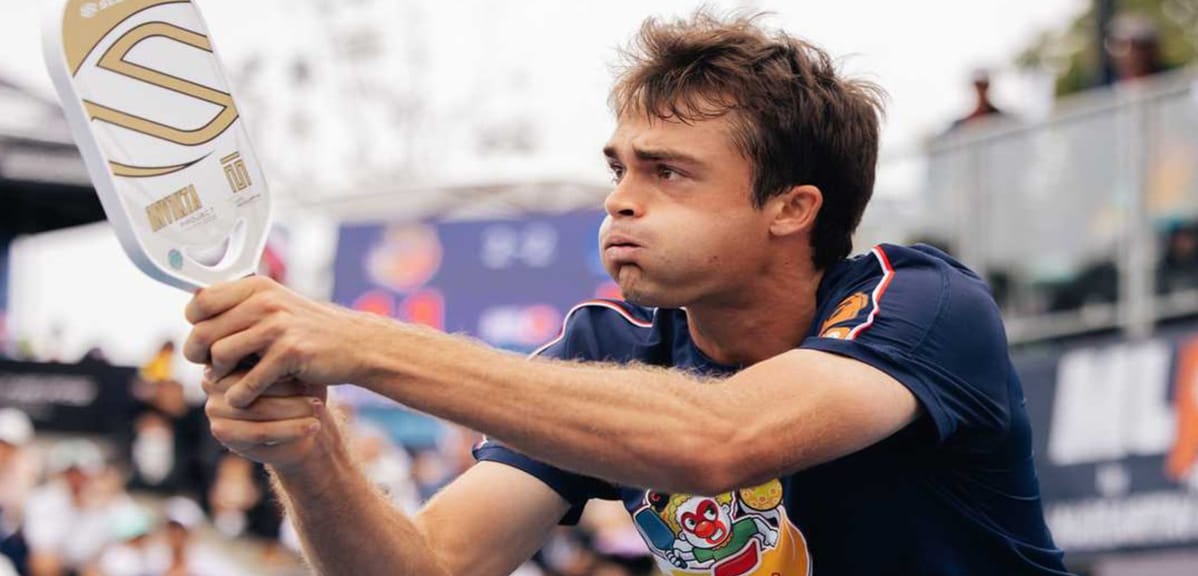
Beginning pickleball players only care about one thing: hitting the ball in bounds. As we progress, we want to do more and more with our game, and we want to score more often. Maybe we even start practicing shots.
We hit serves and overheads and dink for hours (even if most dink rallies these days last two seconds before someone tries a speedup).
However, one essential part of our game is often overlooked: the return of serve. And boy, is that a big BIG mistake.
The importance of the return of serve
As you learn to play better, you discover that the team that makes it to the kitchen line the most scores more often and wins more games. You might call it the game within the game.
In pickleball, the returning team has the advantage at the beginning of every point (because they start with one player already at the NVZ line). When you’re the returning team, you want to keep and enhance that advantage when possible.
With this in mind, the first two goals of every rally should be to
1) Get to the NVZ line, and
2) Keep your opponents off of it
So, on the return of serve, instead of thinking, “Just hit the ball in bounds,” or “How can I score?” try switching your thinking to, “How can I help my team achieve its first two goals?”
Because if you can do that, the points and the wins will follow.
Looking for further proof that the return of serve is one of the most important shots in pickleball?
Check out a recent video from ThatPickleballGuy, Kyle Koszuta, where he discusses the stats behind having a great return of serve:
How to effectively return the serve in pickleball
The best return of serve is hit deep or high–or both. Of course, adding spin also helps, but we’ll get to that.
Return the serve deep
A shallow return of serve opens the playbook for your opponents. They can essentially do whatever they want on their third shot.
However, if you return it deep, you take some of those options away from them, or at least make them work harder for it. You might even force them to back up and hit an off-balanced shot from the baseline.
A deep return of serve gives you time to get to the NVZ line with your partner and sets you up for an easier fourth shot and control of the point.
Return the serve high
Need even more time to get the NVZ line? A high return works great.
Better players may have an easier third shot off a high-bouncing ball, but you and your teammate should be in a great position to react to whatever they do and control the rally.
If it seems silly to hit a high return of serve, just remember your two goals–get to the kitchen line and keep them from getting there. A high return can accomplish both of those goals.
Pickleballers: you play better if you hydrate better.

Better hydration starts with LMNT's perfect ratio. Their electrolyte drink mix is: 1000 mg sodium, 200 mg potassium, 60 mg magnesium.
In other words: all the stuff you need. Nothing you don't.
Return the serve deep and high
The holy grail of returning the serve is returning it deep and high. If you can do that regularly, you’ll be tough to beat.
Return the serve with some juice on it
Ready for the next level? Put some of that sweet spin on your return of serves. It takes some practice, but isn’t that just an excuse to play more pickleball? Adding spin does come with a warning: this spin can be used against you at higher levels.
But at lower levels, your opponents might not know what to do with it.
Pickleball return of serve strategy
Okay, great. Now that you know the options for a great return of serve, let’s discuss how to execute.
Execution Tip #1 - Prepare before the serve
Your return starts before the serve begins. Stop shuffling your feet or spinning your paddle. Prepare before the ball is in the air by being in a ready position and paying attention to where your opponent is trying to serve the ball.
Strategy Tip #2 - Use less steps
The more steps you take, the more mistakes you can make. Take a split step before they make contact to help yourself be balanced and ready to pounce.
Then get your body behind the ball with as few steps as possible, using your hips and exploding off your feet. Ensure the contact point is around knee level and out in front of your body.
Strategy Tip #3 - Short backswing, long follow through
This applies to just about every shot in pickleball, but especially when returning the serve.
Most players have too big of a backswing and don’t finish their follow-through with the paddle over their opposite shoulder. Don’t be those players.
Think: short backswing, long follow-through.
Strategy Tip #4 - Use your legs
Another common mistake players make is using their arms and shoulders instead of their legs. Your lower half has bigger muscles which will help you generate better power.
You'll understand why if you’ve played other sports, like baseball or volleyball. If you don’t have prior experience, this concept may be a little foreign, but you want to use your legs to propel your body into the ball, especially on full shots.
Need a visual example? Check out ThatPickleballGuy’s video and watch Nico demonstrate:
Strategy Tip #5 - Get to the kitchen
Now that you’ve executed the return of serve perfectly, it’s time to get your behind to the NVZ line!
If you can do it before your opponent hits the ball, then BOOM! advantage you. So many players hit the ball, then stop or slowly get up to the line.
This is a huge mistake. Remember the two goals–keep your opponents back and get yourself to the NVZ line.
Common pickleball return of serve mistakes and how to fix them
What do you do when your return of serve isn’t working? Here are some common return-of-serve mistakes and how you might fix them.
Common Mistake #1 - Your return is too short
As we said earlier, a short return gives your opponents too many options.
If you find your return keeps getting crushed, or your opponents are dropping the ball inside the kitchen with ease, consider you might be making one of these errors:
- Your follow-through is too short (especially on backhands)–finish with the paddle at the opposite ear
- You’re missing the sweet spot of your paddle–look the ball into your paddle; don’t look up right before contact
- You’re letting the ball get too deep on your swing–remember, you want to make contact when the ball is out in front of you
Common Mistake #2 - Your return is too long
The opposite of too short is too long, which gives your opponents an immediate point.
While you want to push the envelope, try to aim your return to land about three feet before the baseline, which gives you more room for error.
If you find the ball sailing too long too often, check yourself for these errors:
- Your backswing is too long–try dropping your paddle instead of swinging it back.
- You’re swinging too hard, especially with your arm or shoulder–stop trying to crush the ball and consider hitting with only 70% of your power
- Your paddle face is too open, causing the ball to rise instead of dip–consider your grip or practice closing the paddle face slightly
- You’re using too much of your body’s momentum in your swing–if you try to get to the line before you make contact, it’s easy for the ball to get beyond your body – try keeping the ball out in front of you
Another point worth making, if you find yourself still hitting the ball long, is that you can go cross- court instead of hitting straight in front of you.
There is more space and more room for error.
Common Mistake #3 - Your spin is out of control
Putting spin on the ball takes practice. It’s hard to get good at it if you only use it in games.
However, using concise strokes is the key to generating a good spin on the ball.
The biggest mistake players often make when trying to spin the ball is they loop the paddle too much–giving themselves a long backswing and an uneven follow-through.
If you consider that your arm path is making a “C” when you try to put a spin on the ball, consider switching the path to a lowercase “c” instead. Short, concise, solid contact is the key.
Read Next: 5 Tips to Improve Your Pickleball Backhand
Return of serve drills
Now it’s everyone’s favorite part: drills.
Return of Serve Drill #1 - Footwork first
The best part of this drill is you can do it at home when no one is looking. Pretend someone is about to serve, then:
- split step
- rotate your hips
- drive your feet
- get behind the ball–even if it’s imaginary
Try it on both your forehand and backhand. When you’re ready to take it to the court, simply have your partner (or a ball machine) serve at you over and over again until it feels natural and you’re making solid contact.
Return of Serve Drill #2 - Return it deep
Gather some markers (i.e., cones, sticky notes, water bottles, whatever) and place them three feet from the baseline—one toward the middle line, another on the sideline, and the third in the middle.
Make every return of serve attempt land between the cone and the baseline. Remember to practice forehands and backhands.
Return of Serve Drill #3 - Return it high
If you play inside, you’re limited in how high you can return it. If not, then let it rip! The higher, the better, baby.
Open your paddle face and practice your follow-through. It’ll take a few attempts, but at some point, you’ll get a feel for what works best for you.
Take those same markers as the drill above and try to get your high return to land inside the three feet before the baseline.
Return of Serve Drill #4 - Get to the NVZ line
Once you’re comfortable with your swings, it’s time to move your feet again. Practice hitting the ball, then sprinting to the line. Keep doing it until it’s comfortable for you.
Return of Serve Drill #5 - The lowercase “c”
Grab a paddle and practice this wherever you’re sitting right now. First, mimic a swing and draw a big “C” in the air.
Do it a few times. Now, draw a lowercase “c.” Can you feel the difference? That’s the feeling you need to recreate on the court. That little motion will add plenty of spin to your return of serve.'
Put it all together
It’s time to become a master of returns. Put it all together and take it to the courts. But, don’t be surprised if your games last longer and the wins pile up. Good luck out there!
We send our newsletter subscribers valuable pickleball tips like these three days a week. Up your game by subscribing now.

Love Pickleball? Join 100k+ readers for free weekly tips, news & gear deals.
Subscribe to The DinkGet 15% off pickleball gear at Midwest Raquet Sports









